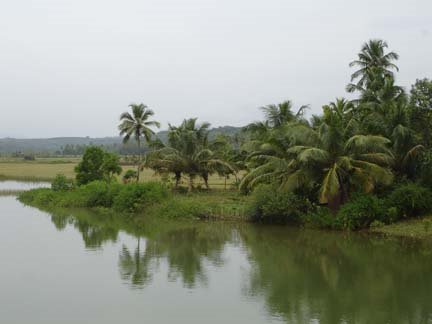
The major evidence for existence and residence of Tulu tribes in the northwestern Indian subcontinent is the existence of a fossil or relict word namely ‘Pirak’ in the present Tulu language. Incidentally, Pirak is name of the area in Baluchistan where the phase of post-Indus civilization was developed between 1800 and 800 BC. Beside there are a number of other evidences like exchange of words with Vedic Indo Aryans, adoption of the Bermer worship
One of the artifacts obtained in Indus civilization resembles boar (see photograph above). In Indus valley civilization, whether this ‘boar’ like artifact could be taken as evidence for the existence of boar worship (Panjurli/Varaha) which was a hallmark of the Tulu tribes needs further verifications. If it is confirmed it may indicate the presence of Tulu tribes in the late phase of Indus Valley civilization.
The civilization in the north western Indian subcontinent is divided into three phases namely:
(a) Mehrgarh (7000-2600 BC),
(b) Indus Valley (2600-1800 BC) and
(c) Pirak(1800-800 BC)
Mehrgarh Civilization phase 7000-2600 BC
Mehrgarh township, located at the foot of the Baluchistan hills (now in Pakistan), is the earliest known farming settlement in South Asia, established circa 7000 B.C. Several villages developed in the hills of Baluchistan and further (ca.3500BC onwards) along the western edge of the Indus plain. The people cultivated wheat and barley and raised sheep, goats and cattle, all traditions that paved the way to civilization. Stone sickles are found that provide evidence of cultivation. Besides, painted pottery, ornaments and terracotta figurines representing both humans and animals have been found.
Settlements on the Indus plain laid the foundation for the Indus Civilization. Cattle yokes and sophisticated copper/bronze implements recovered during the archeological excavations suggest growth of agricultural society in the area and the seals indicate trade with neighbors in the region. Graphic motifs on the pottery such as men with headdresses of buffalo horns may be the beginning of religious beliefs that continued into the later Indus Civilization.
Indus Valley Civilization phase 2600-1800 BC
More than 1,500 archeological sites have been discovered along the Indus (Sindhu) and Sarasvati (Ghaggar –Hakra) River valley/ catchment area by ca. 2600 BC, of which about ten known to be are well planned cities or towns. Among these, Harapa and Mohenjodaro (in Pakistan and Dholavira (Gujarat, India) are the famous sites. The towns, consisting of well planned streets and buildings, were divided into public/administrative and residential section. The use of baked bricks in architecture evolved before and during the Indus Civilization. The towns were linked with each others through rivers, which possibly served as water supply and transportation networks. The town had developed trade relationships with Persian Gulf and Mesopotamia.
Art works recovered during the archeological excavations such as human and animal terracotta figurines, gold ornaments, toys, decorative motifs painted on pottery and other objects made from copper/bronze, shell and semi-precious stones, carnelian beads with bleached white designs (etched with alkaline solution) indicate the affluent urban style of life enjoyed by the citizens of the Valley.
Buffalo horns and pipal trees were regarded as sacred. Depictions on some seals and tablets of men wearing horned headdresses decorated with pipal leaves may have represented religious as well as secular leaders. One of the published artifacts looks like the boar Varaha or the Panjurli, popular spirit in Tulu culture. Fish symbols abound in these areas that have been variously interpreted by scholars like Iravattam Mahadevan and Asko Purpola. Mahadevan suggested Indus to be a proto-Dravidian culture. Asko Purpola suggested that fish pictograms represented religious beliefs. Purpola’s suggestion appears meaningful since in later aprt of the history around 300 BC legend of fish worship was adopted as Matsyavatar, the first incarnation of Lord Vishnu.
Traditions involving the worship of nature and possibly even the "Mother Goddess" were integrated into the traditions of the Indo-Aryan speakers in the form of a reverence for cows, pipal trees, rivers and water.
Most of the cities of the Indus Civilization were abandoned by circa 1800 B.C possibly due to shifting of rivers or famine. Possibly most of these settlements were relocated to the Pirak region.
Pirak civilization phase 1800 to 800 BC
The Pirak Culture evolved consequent upon the decline of the Indus Civilization. It was near the older Mehrgarh sites on the Kachi plain and characterized by geometric polychrome pottery. Here horses and camels were domesticated for the first time in South Asia, and the riding of horses is clearly attested. Sorghum and rice were added as summer crops to the existing winter crop assemblage of wheat and barley. This saw-toothed stone sickle was probably used to harvest cereals. Early Tulu and Early Dravidian tribes picked up the cultivation and consumption of rice in this region. Possibly, the custom of making boiled rice was also initiated in this region, as mentioned in some Greek accounts of the time ca 300 BC. Several other points regarding the Pirak phase of Tulu tribes has been described in previous posts.
Evidences such as urns containing cremated bones and ashes have been recovered, suggestive of development of new tradition burning of dead bodies evolved in the Cemetery H. Horses and camels were utilized for common domestic chores.
®



